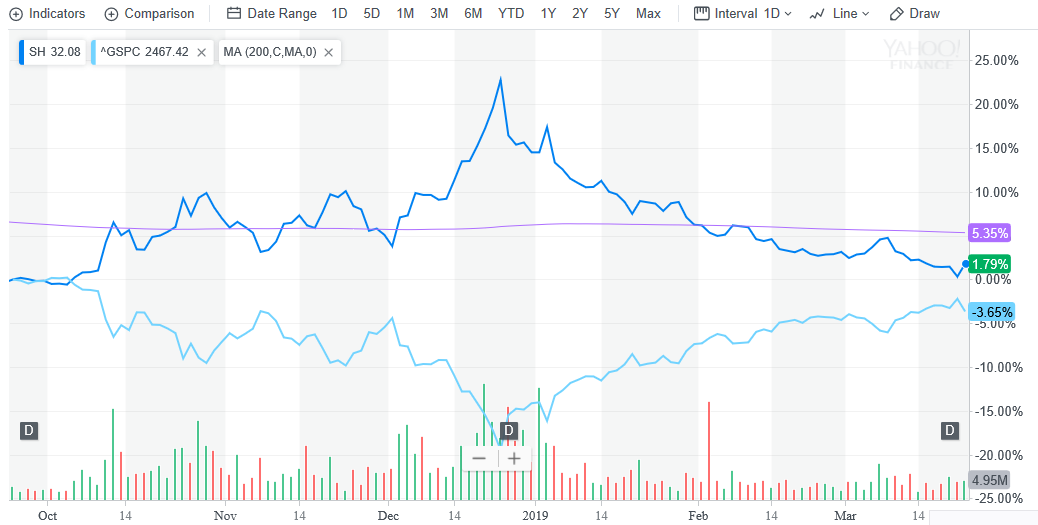Global growth concerns and a more cautious Federal Reserve is doing wonders if you’re a bear when it comes to the S&P 500, particularly the ProShares Short S&P 500 (NYSEArca: SH), which rose 1.60 percent on Friday.
For investors who are predisposed to a long-bias strategy can look at ETFs like the SH ETF if they want to get tactical and take the other side when markets go awry. Certainly investors want the broad market index like the S&P 500 to be performing well, but there are times when they need to bring out their inner bear.
It hearkens back to the 1996 cult film “Swingers” in which actor Vince Vaughn’s character chides the heartbroken protagonist played by Jon Favreau who continues to pine over an ex-girlfriend that unceremoniously left him six months ago. Vaughn’s character, the slick-talking Trent, tries to instill confidence into Favreau’s character, Mike, by re-immersing his buddy back into the dating scene.
How does Mike conjure up the confidence? Trent has the answer: by being a bear.
Investors feeling heartbroken over Friday’s 400-point loss in the Dow Jones Industrial Average and more specifically, a 1.54 percent decline in the S&P 500 as of 2:00 p.m. ET can bring out their own bear with the SH ETF. SH seeks daily investment results that correspond to the inverse (-1x) of the daily performance of the S&P 500® Index, and invests in financial instruments that ProShare Advisors feel will produce daily returns consistent with the fund’s investment objective.
SH primarily tracks the large-cap U.S. stock market performance. SH is a float-adjusted, market capitalization-weighted index of 500 U.S. operating companies and real estate investment trusts selected through a process that factors in criteria such as liquidity, price, market capitalization and financial viability.
With the S&P 500 up 13.88 percent through Thursday’s close year-to-date, SH is obviously on the downside with a loss of 9.93 percent. However, when U.S. equities took a deep-dive into a pool of red in late 2018, SH was a gainer, moving past its 200-day moving average and peaking in mid-December:

Things could get even more bearish with recession signals emanating from the bond markets. Fears of an inverted yield curve racked the markets during 2018’s fourth quarter sell-off, but they returned on Friday as the short-term 3-month and longer-term 10-year yield curve did as such–unveil an inversion that hasn’t been seen since 2007–just ahead of the financial crisis.
“Could it be that the yield curve is signaling weak global economic growth and low inflation without necessarily implying a recession in the US? We think so, and the US stock market apparently supports our thesis,” Ed Yardeni of Yardeni Research said in his morning note Friday. “So why are global stock markets also doing so well? Perhaps there is too much pessimism about the global economic outlook.”
The spread between the 3-month and 10-year notes fell below 10 basis points for the first time in over a decade. This strong recession indicator contrasted a more upbeat central bank on Wednesday, but investors were quick to sense the cautiousness.
During Wednesday’s interest rate announcement by the Fed, Chairman Jerome Powell gave mention to the strength of the economy, but did acknowledge that economic concerns exist domestically and abroad.
“We continue to expect that the American economy will continue to grow at a solid pace in 2019 although likely lower than the very strong pace in 2018,” said Powell. “We believe our current policy stance is appropriate.”
“Since last year, we’ve noted some developments at home and around the world that bear our close attention,” Powell added. “Given the overall favorable conditions in our economy, my colleagues and I will be patient in assessing what, if any, changes in the stance of policy may be needed.”
Notice of the use of “bear” in Powell’s statement. Sometimes when market losses are more than an investor can bear, it may be better to take the other side and just be the bear.
For more market trends, visit ETF Trends.

